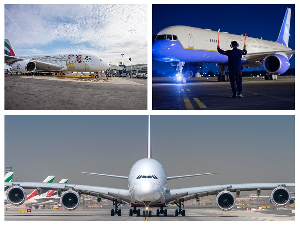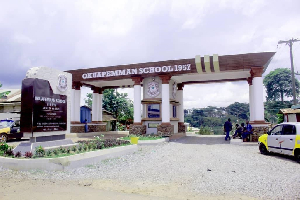- Home - News
- TWI News | TV
- Polls
- Year In Review
- News Archive
- Crime & Punishment
- Politics
- Regional
- Editorial
- Health
- Ghanaians Abroad
- Tabloid
- Africa
- Religion
- Election 2020
- Coronavirus
- News Videos | TV
- Photo Archives
- News Headlines
- Press Release
Business News of Thursday, 15 January 2009
Source: GNA
Meeting Challenges of Ghana's Economic Growth
Accra, Jan. 15, GNA - The World Bank says Ghana appears to be a prime candidate for scaling up donor financial support to accelerate growth and the achievement of the Millennium Development Goals (MDGs) since her policies have been good and its institutional capacity continues to improve.
Excerpts of "Ghana's Economic Memorandum" prepared by the Bank in 2007 and made available to the GNA on Thursday, however, said there were clear bottlenecks in the provision of public goods, such as infrastructure that threatened the ongoing economic expansion. It said additional donor resources combined with better policies and capacity could mitigate these problems and accelerate the achievement of the MDGs.
The memorandum said: "Ghana has demonstrated its ability to absorb substantial amounts of aid relatively effectively. In addition, public resource management has been improving.
"This trend suggests that the absorptive capacity of the economy is not likely to constrain greater and productive use of additional resources in the future, including in the form of aid. Some further scaling-up of aid to Ghana is both desirable and possible, with no adverse effects on competitiveness and no strain on its absorptive capacity, the memorandum said.
It said from the Ghanaian side, such scaling-up of resources must be matched by continued improvements in policies and a value-for-money approach to public sector expenditures.
History
Giving a historical background the memorandum said on March 6, 2007, Ghana celebrated the fiftieth anniversary of its independence with strong growth, continued poverty reduction, and renewed optimism about its future.The country's present determination to reach middle-income status is reminiscent of the optimism and self-confidence that characterized the mood of its original independence celebrations in 1957. At the time of their independence, Malaysia, Mauritius, Singapore, and South Korea were broadly on a par with Ghana in per capita income terms.
These other countries have long since reached--and some have surpassed--middle-income status. For example, with a 2005 Gross National Income (GNI) per capita of $15,840, South Korea is a high-income country, and with $5,250 GNI per capita, Mauritius is upper-middle income. In contrast, despite all of its natural and human resources and favorable coastal position, Ghana lags behind with a 2005 per capita GNI of $450.
A longer-term perspective raises inevitable questions. What went wrong in the early decades? More importantly, what is the basis for today's renewed optimism? Focusing on the most recent growth, what are the sources of its acceleration and poverty reduction, and how sustainable is the growth momentum? What holds Ghana back from reaching even higher, better, and faster on the road to middle-income status? What kind of strategy and policy should Ghana and its partners pursue to achieve key development objectives? Finally, where is Ghana expected to be in 2015 in terms of income, poverty reduction, and the main Millennium Development Goals? These are the questions, in one form or another, on the minds of many Ghanaians and the development community at large.
First 25 Years after Independence
The first half of Ghana's 50 years of independence could be characterized by political instability, mixed development paradigms, and policy reversals. Ghana's long-term economic performance in the early independence years was closely associated with cycles of political instability and shifts in policy regimes, including changes in strategies between state-led and market-led development. The impact of dirigiste state-led policies in the First Republic (1957-66) compounded by the fall in the price of cocoa resulted in significant deterioration in internal and external balances and in the overall economic situation. The following years (1966-72) were characterized by political turmoil and short-lived reforms followed by a period of economic chaos until the early 1980s. Overall, during its first quarter-century of independence, the political and economic policy environment of Ghana was not conducive to dynamic private sector investments, entrepreneurship, and growth. However, since 1983, Ghana has entered a period of relative political stability and gradually improving policy and growth performance. With improved policies, the country also began to receive increasing amounts of financial aid. More recently, since 2000, Ghana has significantly improved its macroeconomic management and economic performance.Slow Start
Its slow start after independence set Ghana back in its race with many other Sub-Saharan African and low-income countries toward long-term growth. Its real per capita annual income growth average over those 50 years has been well below 1 percent. Furthermore, real per capita income has barely doubled over the last 45 years. In contrast, during the same period, with its aggressive export-oriented strategy, Mauritius has sustained average annual per capita growth of above 3 percent, and its income level has almost quadrupled.In a welcome development, since the 1990s, Ghana's economy has begun to advance. Ghana has sustained real GDP growth of above 4 percent and per capita growth of approximately 2 percent. These figures have elevated Ghana toward the medium growth performance among African countries over this period. The Government of Ghana (GoG) now explicitly aims to achieve middle income status by 2015, with an annual GDP growth of 6 percent to 8 percent.
Impressive Gains but Many Constraints Remain
Ghana has recently achieved impressive gains in growth performance and poverty reduction. Improving the policy environment was a major contributor to this success although a benign external environment in terms of agricultural export prices has helped. Economic growth has averaged over 5 percent since 2001 and reached 6 percent in 2005-06. This strong growth nearly halved the poverty rate in Ghana--the proportion of the population below the country's poverty line--from approximately 52 percent at the beginning of the 1990s to 28.6 percent in 2005-06. As a result, Ghana is well ahead of schedule in achieving the key poverty Millennium Development Goal (MDG). In the low-income African context, this achievement is remarkable. Significantly, it is built on the foundation of the improved economic policy environment--based on sound fiscal management--and investment climate, rising private investments, and aid. Alongside Tanzania and Uganda, Ghana is one of the three strongest economic policy performers among low-income African countries.Growth in all Sectors
All sectors of Ghana's economy--especially rural areas--participated in growth. This shared growth was key to the rapid pace of poverty reduction. Rural incomes rose because of greater use of land as well as some productivity gains and higher agricultural export commodity prices. Private, small-holder cocoa farmers were a major beneficiary of rising rural incomes. There are additional reasons for guarded optimism about Ghana's agriculture, as evidenced by the recent success of the horticulture sector (for example, pineapple). Agriculture has the potential to further grow, but it must be supported by improved policies, institutions, and investments. Ghana's large services sector has also grown on the heels of a better climate for private business and investments and rising incomes. The small industrial sector also has shown dynamism, albeit from a low base. Finally, responding to the more favorable economic climate, Ghana's exports have grown, including nontraditional exports.Human Development Indicators
Some human development indicators improved, and aggregate employment increased, although much of it was in the informal sector. However, while Ghana did well in primary education in terms of enrollment, ensuring that children stay in school and make progress has been a challenge. Secondary and university education has not always provided the skills needed by the growing economy. And rural-urban migrations continue unabated, putting pressure on the already high urban unemployment.Income Inequality
Despite these gains, income inequality across regions and between men and women remains high and has increased during this period of accelerated growth. These inequities remain potent sources of political and social tensions. While all main income groups--from the poorest to the richest--have benefited from the economic expansion since the beginning of the 1990s, the gains by the poorest were much lower than those of the rest of society. Despite their major role benefiting the society, women continue to earn much less then men, and poor women are the most economically vulnerable. While all regions saw gains in incomes and a reduction in poverty, these gains and poverty reduction were much less pronounced in the North of Ghana.Management of Aid
Ghana's good overall performance has attracted rising amounts of better-managed aid. Ghana now receives annually approximately $1 billion in various forms of aid, and aid is now more effective than in the past. A lot of aid went into some key sectors such as roads and as a result, the quality of roads in Ghana now is much better. Also, donors are now "harmonizing" aid among themselves and are closely aligning it to Ghana's social and economic priorities.Annual external reviews of Ghana's public financial management note continuous improvements. This good management is one reason that the large volume of aid in Ghana has not resulted in significant downside effects, such as overwhelming the local institutional capacity and reducing competitiveness of Ghanaian products. Aid could be even more effective in the future if it were more predictable and better geared toward identified growth constraints. .
Constraints
What are Ghana's main constraints now to even more rapid growth and poverty reduction? This report identifies three major constraints that, if eliminated, would help Ghana sustain and accelerate growth and poverty reduction in the future. These constraints are:Infrastructure gaps, especially in energy and water and sanitation. In electricity, the power crisis with long cuts and large losses is a stark reminder of the gap between supply and demand that threatens the viability of many businesses, especially in manufacturing and services. In water and sanitation, supply is inadequate and quality often poor. In ICT, interconnectivity remains a problem and the sector is yet to deliver on its promise. Even in roads, the best performing infrastructure sector, there are gaps in rural areas and in connectivity with poor regions. Simply put, Ghana spends approximately 3-4 percent less of GDP per year than is necessary to address the most critical infrastructure gaps in electricity, water and sanitation and, to a lesser extent, in ICT and rural roads. The medium-term shortfall in infrastructure financing is higher--approximately 5-6 percent of GDP. The power crisis is already costing the country at least 1.5 percentage points of GDP per year, and the "silent crisis" in water and sanitation threatens not only economic activity but also public health. .
Productivity remains low, especially in agriculture. .
Ghana's aggregate productivity is improving, but the level remains below the most productive African economies--such as Mauritius and Botswana--and way behind the rapidly growing Asian countries. With irrigation almost nonexistent, Ghana's agriculture still depends largely on weather. Recently, productivity has begun to increase but the use of modern agricultural techniques remains limited. The success stories in Ghana's agriculture, such as cocoa and horticulture (pineapple), provide lessons on how to strengthen the rest of agriculture..Investment Climate.
While improving, several aspects of the business and investment climate remain weak. These constraints hold back Ghanaian firms from investing, expanding output, and hiring more workers as well as becoming more productive. The most important constraints relate to electricity and access to finance, especially for small and medium-size enterprises.Looking Ahead
How can these constraints be overcome, and what can public policy contribute? To begin with, it is necessary to continue what Ghana has been doing well, to improve the overall policy environment in at least three areas: macroeconomic policy, especially fiscal and monetary management; efficiency; and sector policies.Macro Stability
Increasingly, the cornerstone of Ghana's recent macro stability has been prudent fiscal and monetary policies. This stability must continue if Ghana is to further reduce interest rates, increase private investments, and continue to attract favorable investment ratings and donor support. First and foremost, this means sustaining prudent fiscal stance and borrowing levels consistent with debt sustainability. In this context, it is important for Ghana to maintain fiscal prudence over the political cycle and resist two types of pressures. First is pressure for the budget to pay for inefficient tariff policies and energy companies' operations. Second are the pressures to raise the already large government wage bill beyond the levels justified by fiscal affordability and productivity? Increasing the productivity of public sector personnel and using resources more efficiently will be important, hence, the important emphasis should be to improve efficiency and value-for-money at all levels of public sector activities. Nevertheless, while maintaining macro stability is important, it is not sufficient to guarantee accelerated growth.This requires focusing directly on identified growth constraints, as follows:
Closing the infrastructure gap
This will require urgent efforts by policymakers and implementing agencies on the financing, policy and regulatory and institutional fronts. Specifically, short-term efforts over the next 12 months should focus on:
Eliminating the short-term annual funding shortfall estimated at US$350-430 million (3-4 percent of GDP); and targeting the main bottlenecks in electricity, water and sanitation, ICT, and some rural roads. Funding for this scaling-up in infrastructure could come from a combination of domestic and external resources, preferably on concessional term.
Accelerating tariff reform toward average cost recovery while safeguarding the poor's affordability with a suitable design of "lifeline" tariffs or alternative ways of striking a balance between revenue and social concerns in tariff policy.
Politicization
Strengthening regulation and depoliticizing sector management. Ghana must aggressively seek opportunities for greater private participation in infrastructure development, especially in energy and ICT.Raising Agriculture Productivity
Addressing infrastructure bottlenecks will also help raise productivity in the economy. Without water supply and electricity, there is no refrigeration; and without refrigeration, there is no vibrant commercial fishing industry and associated food chains. Productivity is fundamental to long-term growth. Some new technologies, such as cellular/IT, offer opportunities to "leapfrog" into higher and more productive, new economic sectors that offer promise of new jobs, investments and growth. Additional opportunities beyond infrastructure must be sought to sustainably enhance productivity in sectors important to the wellbeing of Ghanaians--in agriculture, for example. The most important of Ghana's future productivity improvements are likely to be through the competitive entry of new and more productive enterprises, as well as the growth of existing firms, and through increasing the available skilled labor. To these ends, policy efforts should focus on:Elimination of Bottlenecks
Eliminating infrastructure bottlenecks and widening the use of technology and ICT transferring to other agriculture sectors the lessons of recent productivity gains in the cocoa sector as a result of disease control, fertilizers, and better product varieties. The last shows that aggressive productivity-enhancing measures on privately owned farms can have major impacts on productivity and output. Introducing in the public sector a new value-for-money and productivity-enhancing mindset that will lead to better use of resources and wider space for private sector innovation in the new technology-intensive sectors that offer opportunities for leapfrogging.Strengthening the investment climate
Recent surveys including the World Bank's 'Doing Business (2007)' and Association of Ghana Industries (AGI) surveys as well as the most recent World Bank Investment Climate Survey reported in the Ghana CEM indicate that the investment climate is improving and there is investor optimism. However, these are happening from a low base, and there remain serious concerns in at least two notable areas: electricity and access to finance by small and medium-size enterprises. Thus, the improvements in investment climate must be extended and sustained over the long term, especially in these areas. While other areas of the investment climate are much less of a problem, certain business regulations could be improved. For example, procedures for formal business start-ups are still too cumbersome and push firms to informality.Role of Exports
Exports will need to play an increasing role as an engine of growth and export diversification will need to be promoted. It is no accident that all successful stories of development are linked with rapid and sustained export growth, even in Africa ( Mauritius, Botswana).As a small open economy, Ghana, therefore, must grow not only using its small domestic market but tapping the potential of unlimited global markets. While Ghana has begun to develop non-traditional exports, much more needs to be done. The report details opportunities to expand existing and develop new exports up the value chain but also based on existing natural resources. There are no easy answers here, but one thing is certain: Ghana must avoid the overvaluation of its currency that would hurt export and growth prospects. This is perhaps a central lesson that must be heeded for there is no example of rapidly growing economies with overvalued currency. So far, Ghana has managed this challenge well and it must continue to do so in the future.Sharing of Benefits
To ensure wider sharing of the benefits of growth, Ghana could well consider more active regional infrastructure policy and greater attention to regional and gender disparities. Effective regional infrastructure policy will require identifying, professionally appraising and implementing regional projects that connect poor regions with centers of the mainstream economy as well as with neighboring countries in the North. With more detailed geographical poverty and infrastructure data now available, greater precision is possible in identifying geographic pockets of poverty that could be targeted by policy aimed at linking those isolated areas with basic services and centers of economic activity. Promoting gender equality in economic opportunities and education must be high on the policy agenda. Also, new growth will increasingly demand more skilled workers and building skills of new generations will be an important element of a strategy for shared growth. The analysis of the political economy in this report also suggests that reforms will work better and will be accepted more widely within society if citizens are more informed about basic policies, key economic and social data, and policy choices.No Room for Complacency
Against this background, Ghana will continue to face--and will need to manage-- important risks, so there 'is no room for complacency'. The main short term risk is the energy crisis that must be resolved urgently. But there are also macroeconomic, environmental, and external risks to rapid growth in Ghana. As noted,sustaining macroeconomic stability and enhancing public sector capacity and efficiency is a constant must . Environmental degradation also must be dealt with, as well documented elsewhere (Natural Resource Study). Finally, as a small open economy, Ghana remains vulnerable to external shocks over which it has little control: commodity prices, climatic conditions, regional tensions, and fluctuations in global, international trade and investment flows. The best way for Ghana to manage these risks is to build resilience by strengthening its own policies, institutions, and capacity.Elimination of Constraints
If the above growth constraints are eliminated and policies and institutions strengthened, Ghana faces strong medium-term prospects--but they should not be taken for granted. The report analyzes the medium-term prospects in detail and spells out three possible medium-term scenarios. It should be noted that none of these fairly positive scenarios would materialize if economic policy fails: this Ghana cannot afford.Under the 'baseline medium-term scenario' with current policies and short-term restoration of the energy balance--which is a must if Ghana is to continue to grow rapidly--but no major additional infrastructure investments, Ghana's real GDP growth could improve to approximately 7 percent. As noted, above, sustaining macroeconomic stability and further enhancing public sector efficiency will be required. This results in the key poverty MDG being achieved well ahead of schedule, possibly by 2008-09. However, the achievement of the other MDGs would be mixed and reaching MDGs on health and water and sanitation will continue to be elusive. The biggest short-term risk to this scenario is the ongoing energy crisis and all policy efforts should focus on this priority.










